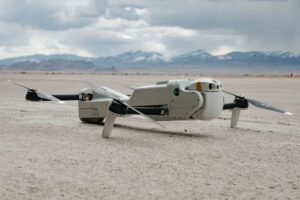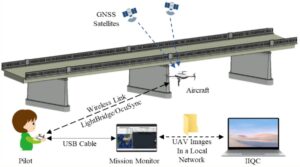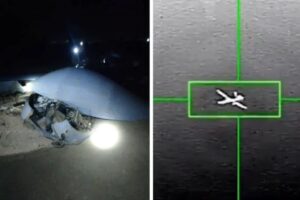The DJI Two-Way Charging Hub is a handy accessory for drone owners seeking to recharge their batteries quickly and efficiently. It acts as a portable charging station, allowing you to juice up multiple batteries without needing to plug them into your drone or an outlet each time.
But it costs an additional $39 for the cheapest version (that’s the DJI Mini 2 edition) and costs up to $49 for the version designed for the DJI Avata 2. If money is truly no object for you, then you’ll definitely want to add a two-way charging hub to your DJI drone kit. But for everyone else, is the DJI Two-Way Charging Hub worth it?
Everything you need to know about the DJI Two-Way Charging Hub
How it works
There are a few models of DJI Two-Way Charging Hubs, depending on your specific drone. After all, drones have various battery sizes, which means different sizes of a hub needed too.
In general, though, they all function similarly.
- Plug and Play: Simply connect the charging hub to a power source using a USB-C cable.
- Insert Your Batteries: Slide your drone’s batteries into the designated charging slots on the hub. Again, the hub is compatible with specific DJI drone models, so make sure you have the right version. The charging hub automatically recognizes the battery at the highest level, and works to get that one to a full charge first. It then moves onto the next most-charged battery.
- Monitor Charging Status: The integrated LED lights indicate the charging status of each battery. A solid light usually means a full charge, while a blinking light indicates charging in progress.
The charging speed depends on the wattage of the USB-C power source you use. For example, when paired with the DJI 65W Portable Charger, the DJI Avata 2 Two-Way Charging Hub can fully charge an Intelligent Flight Battery in only 45 minutes.
Using a higher wattage charger will reduce charging time.
What about Power Bank mode?
Yes, you can use the hub as a power bank. To do that locate the USB-C output port and connect your device’s charging cable. That makes this little piece of hardware cable not just of charging drones, but also other DJI products like the DJI Pocket Series, DJI Goggles or Osmo Action. It also makes it possible to charge phones and tables.
What drone batteries are compatible with the DJI Two-Way Charging Hub?
There are different versions of the DJI Two-Way Charging Hub designed for specific DJI drone models. Make sure you purchase the compatible version for your drone’s battery type. Here’s a quick guide to some of the latest versions of the two-way charging hubs available today:
- DJI Mini 2 Two-Way Charging Hub ($39): compatible with DJI Mini 2 SE, DJI Mini 2, DJI Mini SE
- DJI Mini 3 and 4 Pro Two-Way Charging Hub ($49): compatible with DJI Mini 4 Pro, DJI Mini 3 Pro, DJI Mini 3
- DJI Avata 2 Two-Way Charging Hub ($59): compatible with DJI Avata 2
Benefits of the DJI Two-Way Charging Hub
Frequent DJI drone pilots — especially those who have plans to fly practically the whole day, likely will want to quickly recharge batteries. That’s critical for people using drones for situations like filmmaking. Those pilots constantly need to recharge batteries while out on the set.
Here are the top benefits of the DJI Two-Way Charging Hub:
- Faster charging: Not only are you looking at faster charging, but you avoid the hassle of charging batteries one by one. Pop all three in the charger, go about your life, and return to three charged batteries.
- Efficient sequencing: Every model of the DJI Two-Way Charging Hub is capable of charging multiple, compatible DJI drone batteries in sequence. This means one battery charges at a time, until all three are full.
- Can charge other devices too: You’re not limited to drone batteries. These charging hubs can be used as a power bank to charge other devices like your smartphone or tablet through the hub’s USB port. Of course, you will need at least one battery in storage to make this happen.
Power accumulation function
Newer versions, such as the two-way charging hub for the Avata 2, also have an additional smart accumulation feature. To use it, press and hold the function button with at least two batteries inserted. The hub then transfers the remaining power from multiple batteries to the battery with the highest remaining power. That instantly gives you one battery with the power of all the remaining.
So, let’s say you needed to take a long flight ASAP, but you only had a 50%-charged battery. If you had two other batteries at, say, 25% (which is likely too low to even take off for most normal flights), you could insert all three into the charging hub. Press the power accumulation function button, and bam. You have one battery at 100% full charge.
Alternatives to the DJI Two-Way Charging Hub

But for all the benefits of the DJI Two-Way Charging Hub, it’s not necessarily for everyone. It’s definitely not the only way to charge your drone batteries. Alas, it’s also not the only way to do so affordably.
Especially since practically every DJI drone uses a different DJI battery, most of these two-way charging hubs are unique to just one (or a small handful of) DJI drone model(s). That’s particularly annoying if you choose to upgrade your DJI drone to a newer model. Not only are you spending money on a new drone, but you’d need an all-new charging hub too, in most cases.
For example, the DJI Avata 2 Two-Way Charging Hub is compatible with, well, only the DJI Avata 2. Should you decide to upgrade from the DJI Avata to the Avata 2, you’ll owe an additional $59 for the Avata 2-specific charging hub. That’s on top of the $999 you’re already paying for the Avata 2 drone itself.
Here are some alternatives to the DJI Two-Way Charging Hub:
- Standard battery charger: The charger that comes with your DJI drone can charge your batteries. You’ll have to charge one by one. But hey, don’t be fooled into thinking you need to spend more money on a charging hub. You can technically charge your battery with what’s included in the standard box.
- Portable power bank: A high-capacity, portable power bank with a USB-C output can be used to charge your drone batteries. Just be sure it has enough wattage to support the battery requirements. So, your tiny portable smartphone charger likely won’t work. But, something robust like DJI Power definitely can.
- Two-way charging hubs from third parties: Then there are the third-parties that make replicas of DJI’s versions, at a much lower price. For example, =the official DJI version of the hub for the DJI Mini 2 costs $39. Meanwhile, here’s a third-party version for just $24. I haven’t independently reviewed any of these, so I can’t in good faith ‘recommend’ them. But, purchasing the ‘knock-off’ version could be a good way to save money. Just read the reviews carefully if you do.
The post DJI Two-Way Charging Hub: how it works, and is it worth it? appeared first on The Drone Girl.










